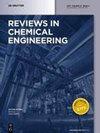膜处理对微量有机化合物的排斥:机制、挑战和机遇
IF 6.6
3区 工程技术
Q1 ENGINEERING, CHEMICAL
引用次数: 4
摘要
摘要本文综述了各种膜分离工艺(MSPs)在处理痕量有机物污染水(TOrCs)中的应用,重点介绍了纳滤(NF)、反渗透(RO)、膜生物反应器(MBR)、正渗透(FO)和膜蒸馏(MD)。此外,重点是研究膜排斥/保留TOrCs的机制时存在的漏洞,重点是TOrCs模型的特征,这将有助于识别所有潜在的排斥机制。还解释了为什么使用真实的水样研究截留率很重要,特别是在针对新型材料膜的工业应用时。NF和RO等MSP容易结垢,这通常会导致较低的渗透通量和溶质截留率,可能是由于滤饼增强浓度极化(CECP)效应。这篇综述证明了为什么CECP效应并不总是观察到的被污染的膜对TOrCs的排斥下降的原因。为了减轻污染,研究人员经常通过加入纳米颗粒来修饰膜表面。这篇综述还试图解释为什么纳米工程膜没有在工业规模上取得突破。最后,深入了解了利用太阳能和风能驱动能源密集型MSP的可能性。还关注如何存储低品位能量,并将其应用于FO模式下回收稀释的提取溶液。本文章由计算机程序翻译,如有差异,请以英文原文为准。
Rejection of trace organic compounds by membrane processes: mechanisms, challenges, and opportunities
Abstract This work critically reviews the application of various membrane separation processes (MSPs) in treating water polluted with trace organic compounds (TOrCs) paying attention to nanofiltration (NF), reverse osmosis (RO), membrane bioreactor (MBR), forward osmosis (FO), and membrane distillation (MD). Furthermore, the focus is on loopholes that exist when investigating mechanisms through which membranes reject/retain TOrCs, with the emphasis on the characteristics of the model TOrCs which would facilitate the identification of all the potential mechanisms of rejection. An explanation is also given as to why it is important to investigate rejection using real water samples, especially when aiming for industrial application of membranes with novel materials. MSPs such as NF and RO are prone to fouling which often leads to lower permeate flux and solute rejection, presumably due to cake-enhanced concentration polarisation (CECP) effects. This review demonstrates why CECP effects are not always the reason behind the observed decline in the rejection of TOrCs by fouled membranes. To mitigate for fouling, researchers have often modified the membrane surfaces by incorporating nanoparticles. This review also attempts to explain why nano-engineered membranes have not seen a breakthrough at industrial scale. Finally, insight is provided into the possibility of harnessing solar and wind energy to drive energy intensive MSPs. Focus is also paid into how low-grade energy could be stored and applied to recover diluted draw solutions in FO mode.
求助全文
通过发布文献求助,成功后即可免费获取论文全文。
去求助
来源期刊

Reviews in Chemical Engineering
工程技术-工程:化工
CiteScore
12.30
自引率
0.00%
发文量
37
审稿时长
6 months
期刊介绍:
Reviews in Chemical Engineering publishes authoritative review articles on all aspects of the broad field of chemical engineering and applied chemistry. Its aim is to develop new insights and understanding and to promote interest and research activity in chemical engineering, as well as the application of new developments in these areas. The bimonthly journal publishes peer-reviewed articles by leading chemical engineers, applied scientists and mathematicians. The broad interest today in solutions through chemistry to some of the world’s most challenging problems ensures that Reviews in Chemical Engineering will play a significant role in the growth of the field as a whole.
 求助内容:
求助内容: 应助结果提醒方式:
应助结果提醒方式:


